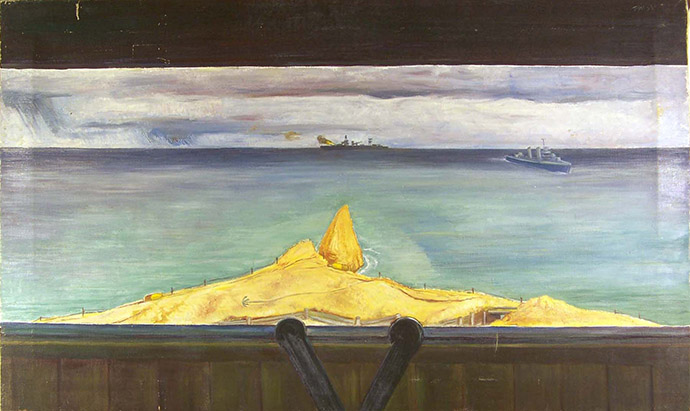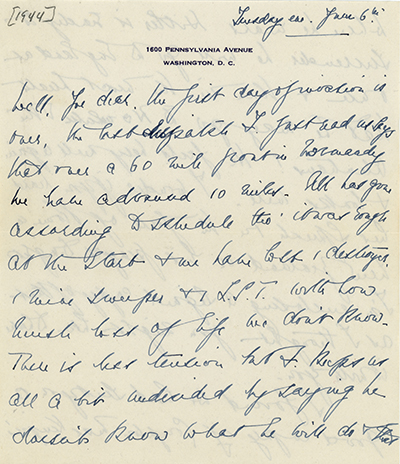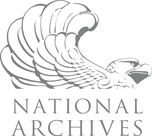 Affichage de contenus web
Affichage de contenus web

As dawn broke on June 6, 1944, German soldiers defending the French coast at Normandy beheld an awe-inspiring sight—the largest amphibious invasion force in history massed in the waters of the English Channel. The long-awaited invasion of northwest Europe was underway.
The giant invasion had taken years to organize. Hundreds of thousands of men and millions of tons of weapons and equipment were transported across the Atlantic Ocean to Britain in advance of the operation. The invasion force consisted chiefly of Americans, Britons, and Canadians. But troops of the Free French and many other nations also participated.
The invasion was the culmination of Franklin Roosevelt’s Grand Strategy, especially his decision to pursue a “Germany First” policy and his insistence—in the face of Churchill’s preference for a peripheral strategy—that the operation go forward in 1944.
The Normandy invasion established a solid “Second Front” in Europe. Its success left Hitler’s armies trapped in a vise, fighting the Red Army in the East and an expanding Anglo-American-Canadian force in the West.
During the tense early hours of the invasion, FDR monitored reports from the front. That evening, he delivered a statement to the American people. It took the form of a prayer, which he read on national radio.
 Affichage de contenus web
Affichage de contenus web
Franklin D. Roosevelt’s D-Day Prayer
On the night of June 6, 1944, President Roosevelt went on national radio to address the nation for the first time about the Normandy invasion. His speech took the form of a prayer.
The date and timing of the Normandy invasion had been top secret. During a national radio broadcast on June 5 about the Allied liberation of Rome, President Roosevelt made no mention of the Normandy operation, already underway at that time.
When he spoke to the country on June 6, the President felt the need to explain his earlier silence. Shortly before he went on the air, he added several handwritten lines to the opening of his speech that addressed that point. They read: "Last night, when I spoke to you about the fall of Rome, I knew at that moment that troops of the United States and our allies were crossing the Channel in another and greater operation. It has come to pass with success thus far."
Text of Radio Address - Prayer on D-Day, June 6, 1944:
"My fellow Americans: Last night, when I spoke with you about the fall of Rome, I knew at that moment that troops of the United States and our allies were crossing the Channel in another and greater operation. It has come to pass with success thus far.
And so, in this poignant hour, I ask you to join with me in prayer:
Almighty God: Our sons, pride of our Nation, this day have set upon a mighty endeavor, a struggle to preserve our Republic, our religion, and our civilization, and to set free a suffering humanity.
Lead them straight and true; give strength to their arms, stoutness to their hearts, steadfastness in their faith.
They will need Thy blessings. Their road will be long and hard. For the enemy is strong. He may hurl back our forces. Success may not come with rushing speed, but we shall return again and again; and we know that by Thy grace, and by the righteousness of our cause, our sons will triumph.
They will be sore tried, by night and by day, without rest-until the victory is won. The darkness will be rent by noise and flame. Men's souls will be shaken with the violences of war.
For these men are lately drawn from the ways of peace. They fight not for the lust of conquest. They fight to end conquest. They fight to liberate. They fight to let justice arise, and tolerance and good will among all Thy people. They yearn but for the end of battle, for their return to the haven of home.
Some will never return. Embrace these, Father, and receive them, Thy heroic servants, into Thy kingdom.
And for us at home -- fathers, mothers, children, wives, sisters, and brothers of brave men overseas -- whose thoughts and prayers are ever with them--help us, Almighty God, to rededicate ourselves in renewed faith in Thee in this hour of great sacrifice.
Many people have urged that I call the Nation into a single day of special prayer. But because the road is long and the desire is great, I ask that our people devote themselves in a continuance of prayer. As we rise to each new day, and again when each day is spent, let words of prayer be on our lips, invoking Thy help to our efforts.
Give us strength, too -- strength in our daily tasks, to redouble the contributions we make in the physical and the material support of our armed forces.
And let our hearts be stout, to wait out the long travail, to bear sorrows that may come, to impart our courage unto our sons wheresoever they may be.
And, O Lord, give us Faith. Give us Faith in Thee; Faith in our sons; Faith in each other; Faith in our united crusade. Let not the keenness of our spirit ever be dulled. Let not the impacts of temporary events, of temporal matters of but fleeting moment let not these deter us in our unconquerable purpose.
With Thy blessing, we shall prevail over the unholy forces of our enemy. Help us to conquer the apostles of greed and racial arrogancies. Lead us to the saving of our country, and with our sister Nations into a world unity that will spell a sure peace a peace invulnerable to the schemings of unworthy men. And a peace that will let all of men live in freedom, reaping the just rewards of their honest toil.
Thy will be done, Almighty God.
Amen."
 Affichage de contenus web
Affichage de contenus web
My Day column for June 6, 1944
Eleanor Roosevelt’s My Day column ran six days a week from 1936 to 1962. Nationally syndicated, her columns discussed important issues, activities and interests, and reached millions of Americans every day. Below is the full text of the column drafted by Eleanor Roosevelt on the day of the Normandy invasion:
[My Day draft] "WASHINGTON, Tuesday—So at last we have come to D-Day, or rather, the news of it reached us over the radio in the early hours of the morning on June the 6th. The first people I saw seemed very much excited. Curiously enough, I have no sense of excitement whatsoever. It seems as though we have been waiting for this day for weeks, and dreading it, and now all emotion is drained away.
All the preparation that has gone on, the endless photographing, the endless air raids, the constant practice of the men in landing, or in whatever their specialty may be—this is now ended. The fact that boys you know have been waiting with an almost desperate feeling for this day, when all their training would be tested, made you dread it and yet hope for it.
The time is here, and in this country, we live in safety and comfort and wait for victory. It is difficult to make life seem real. It is hard to believe that the beaches of France, which we once knew, are now places from which, in days to come, boys in hospitals over here will tell us that they have returned. They may never go beyond the water or the beach, but all their lives, perhaps, they will bear the marks of this day. At that, they will be fortunate, for many others won't return.
This is the beginning of a long, hard fight, a fight for ports where heavy materials of war must be landed, a fight for airfields in the countries in which we must operate. Day by day, miles of country may be taken, lost and retaken. That is what we have to face, what the boys who are over there have been preparing for and what must be done before the day of victory. That day is coming surely. It will be a happy and glorious day. How can we hasten it?
The best way in which we can help is by doing our jobs here better than ever before, no matter what these jobs may be. Every unauthorized and unwarranted strike is an added danger to the boys over there, and a man or woman leaving a war plant today adds to some soldier's load. But on the other hand, we should remember that every employer who forces his employees into a position from which they see no way out except to strike is as guilty as the strikers. I have seen so many condemnations of strikers, but I have seen little recognition that there are always two sides to any dispute. Therefore the responsibility for whatever happens today which slows up production, which we need so desperately in every theater of the war, does not lie with one group alone.
E. R."
 Affichage de contenus web
Affichage de contenus web
More from the Archives and Museum
Oil Painting - View from Command Post in Normandy
The fortified German stronghold at Pointe du Hoc – situated between Utah Beach and Omaha Beach – was among the most important Allied targets on D-Day. The U.S. 2nd Ranger Battalion was given the daunting task of scaling the 100 foot cliff at Pointe du Hoc and destroying the five German 155 mm guns believed to be there. After scaling the cliff under heavy fire, the Rangers discovered that the guns had been moved inland. The Rangers sent out patrols, discovered the guns unattended, and disabled them.
Lieutenant Frederick S. Wight of the U.S. Navy was appointed to make drawings of the Normandy beaches during the Overlord operation. Lieutenant Wight made sketches from Pointe du Hoc while the Allied beachhead was still under fire, completing the drawings aboard ship in the English Channel.
This oil painting is one result of Wight’s work during the invasion. The painting shows a view from the Pointe du Hoc command post through a narrow horizontal slit in a reinforced concrete wall. The observer looks out towards the English Channel at the U.S. battleship Texas firing at Pointe du Hoc and the U.S. destroyer Harding coming inshore to bombard from close range. The painting was presented to President Roosevelt by Lieutenant George M. Elsey in the White House Map Room on behalf of the artist on September 7, 1944.

 Conteneur d'applications
Conteneur d'applications
 Affichage de contenus web
Affichage de contenus web
Eleanor Roosevelt Reflects on D-Day
On the evening of June 6, 1944, Eleanor Roosevelt wrote to her friend Joe Lash who was serving in the Pacific:
"Well, Joe dear, the first day of invasion is over, the last dispatch F.[FDR] read us says that over a 60 mile front in Normandy we have advanced 10 miles. All has gone according to schedule tho' it was rough at the start and we have lost 1 destroyer, 1 mine sweeper, and 1 LST with how much loss of life we don't know. There is less tension but F. keeps us all a bit undecided by saying he doesn't know what he will do and that when he hears Hitler is ready to surrender he will go to England at once and then in the next breath that he may go to Honolulu and the Aleutians. He feels very well again and looks well. I wonder if you heard his speech on the fall of Rome in New Zealand or his prayer tonight? I'm enclosing a signed copy of that as I thought you might like to have it with you." Joe Lash Papers, FDR Library.
 Conteneur d'applications
Conteneur d'applications
 Affichage de contenus web
Affichage de contenus web

 Affichage de contenus web
Affichage de contenus web
Special Exhibit
“D-Day: FDR and Churchill’s ‘Mighty Endeavor’” marks the 75thanniversary of the Allies' greatest military achievement, the June 6, 1944, invasion of Normandy. Code-named Operation OVERLORD it sealed the fate of Adolf Hitler’s Nazi regime.
This exhibit explores a friendship often called the most important of the twentieth century. Forged amid the most devastating war in human history, it has attained an almost mythic status. The complexity of their “special relationship” is revealed in the top-secret communications that flowed back and forth across the Atlantic as they debated and decided on the greatest amphibious assault in the annals of war.
“D-Day: FDR and Churchill’s Mighty Endeavor” is open to the public in the William vanden Heuvel Gallery from May 25, 2019 until January 6, 2020.
 Affichage de contenus web
Affichage de contenus web
D-Day: A Turning Point in World War II
The D-Day invasion opened up the long-awaited Second Front against Hitler. The United States and its allies had launched the greatest amphibious invasion in history on the shores of France. Over 150,000 soldiers, sailors, and airmen stormed the beaches of Normandy beginning a campaign that would end with the unconditional surrender of Germany in May 1945. In August, a second Allied invasion force landed on France’s southern coast. Soon Paris was liberated, and by the fall, Allied armies were poised to cross the German border.
For more information, see the special online exhibit, D-Day and the Normandy Invasion, hosted by the National Archives and Google Cultural Institute.





